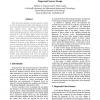Free Online Productivity Tools
i2Speak
i2Symbol
i2OCR
iTex2Img
iWeb2Print
iWeb2Shot
i2Type
iPdf2Split
iPdf2Merge
i2Bopomofo
i2Arabic
i2Style
i2Image
i2PDF
iLatex2Rtf
Sci2ools
HAPTICS
2002
IEEE
2002
IEEE
Understanding of Fingernail-Bone Interaction and Fingertip Hemodynamics for Fingernail Sensor Design
When the human fingertip is pressed against a surface or bent, the hemodynamic state of the fingertip is altered due to mechanical interactions between the fingernail and bone. Normal force, shear force, and finger extension/flexion all result in different patterns of blood volume beneath the fingernail. This phenomenon has been exploited in order to detect finger forces and finger posture by creating a photoplethysmograph “fingernail sensor,” which measures the two-dimensional pattern of blood volume beneath the fingernail. In this paper, the anatomical structure of the fingertip is investigated in order to understand the various ways in which the bone and nail interact to alter the hemodynamic state of the fingertip. A qualitative nail-bone interaction model is created and used to explain the different blood volume patterns that result from each stimulus. The model is verified using experimental data from the fingernail sensor. The impact of this study on potential performance a...
| Added | 14 Jul 2010 |
| Updated | 14 Jul 2010 |
| Type | Conference |
| Year | 2002 |
| Where | HAPTICS |
| Authors | Stephen A. Mascaro, H. Harry Asada |
Comments (0)

